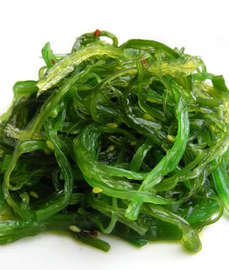
large plant-like algae growing in the sea or on rocks below the high-water mark. Seaweeds are simpler than flowering plants. Unlike plants that absorb nutrients through their roots, seaweed absorbs nutrients through all parts of its tissues.
Edible seaweeds include the red algae, green algae, and brown algae.
Seaweed and marine algae have more concentrated nutrition than vegetables grown on land and they are attributed health properties related to longevity, beauty and health. It is thought to have antiviral, antibacterial, and antiinflammatory properties. Seaweed is high in Iodine maintaining a healthy thyroid function, also calcium, iron, magnesium and vitamin C (more than in oranges). For thousands of years, this marine vegetable has been a staple in Asian diets.
The red seaweed Chondrus crispus, rich in dietary fiber and oligosaccharides, was shown to increase the population of beneficial bacteria such as Bifidobacterium breve increased while decrease pathogenic species such as Clostridium septicum and Streptococcus It also increased concentrations of short chain fatty acids, including acetic, propionic and butyric acids
Seaweed is also known as kaiso, weeds, agar, irish moss, kelp, laver, spirulina, wakame, dried weed, nori sheets, and marine algae.
Edible seaweeds include the red algae, green algae, and brown algae.
Seaweed and marine algae have more concentrated nutrition than vegetables grown on land and they are attributed health properties related to longevity, beauty and health. It is thought to have antiviral, antibacterial, and antiinflammatory properties. Seaweed is high in Iodine maintaining a healthy thyroid function, also calcium, iron, magnesium and vitamin C (more than in oranges). For thousands of years, this marine vegetable has been a staple in Asian diets.
The red seaweed Chondrus crispus, rich in dietary fiber and oligosaccharides, was shown to increase the population of beneficial bacteria such as Bifidobacterium breve increased while decrease pathogenic species such as Clostridium septicum and Streptococcus It also increased concentrations of short chain fatty acids, including acetic, propionic and butyric acids
Seaweed is also known as kaiso, weeds, agar, irish moss, kelp, laver, spirulina, wakame, dried weed, nori sheets, and marine algae.